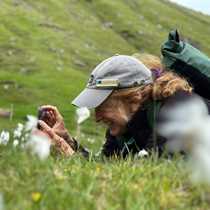Columbia River
Well chosen words can create a mental image as strong as any photograph. We awoke with the backdrop of Mt. Fuji this morning as we made our way towards The Dalles lock. With that one statement, the image of a steep-sided snow-capped peak comes instantly to mind. While we are no where near Mt. Fuji, both it and our Mt. Hood were formed in the same manner from exceedingly viscous material being ejected from their respective volcanoes.
In his writings Meriwether Lewis used the technique of comparison as a tool which has aided readers to visualize Lewis’s findings. Lewis drew from his extensive knowledge of eastern flora and fauna as a continual reference. Whenever possible, he supplemented his writings with pressed plant specimens or collected, prepared and preserved animal skins. After spending the winter of 1804 with the Mandan Indians, the keel boat and some men were sent back to St. Louis. An assortment of plant specimens and a couple of live animals were sent downstream on that boat as well. Two species survived their journey back to Jefferson, the black-billed magpie and the prairie dog.
First references to the prairie dog in the journals described it as a “restless burrowing rodent” and a “barking squirrel.” Two comparisons that bring forward a mental image of a small, fuzzy brown critter. Sergeant Ordway was the first to coin name of “prairie dog” and that name stays with us today.
We capture images with our cameras which we will later share with friends and family. But what do we say when they’re not familiar with the creature in the photo we just called a “yellow-bellied marmot?” We can fall back on comparison and describe it as “a gopher on steroids with a longer tail.” They’ll get the picture.
Well chosen words can create a mental image as strong as any photograph. We awoke with the backdrop of Mt. Fuji this morning as we made our way towards The Dalles lock. With that one statement, the image of a steep-sided snow-capped peak comes instantly to mind. While we are no where near Mt. Fuji, both it and our Mt. Hood were formed in the same manner from exceedingly viscous material being ejected from their respective volcanoes.
In his writings Meriwether Lewis used the technique of comparison as a tool which has aided readers to visualize Lewis’s findings. Lewis drew from his extensive knowledge of eastern flora and fauna as a continual reference. Whenever possible, he supplemented his writings with pressed plant specimens or collected, prepared and preserved animal skins. After spending the winter of 1804 with the Mandan Indians, the keel boat and some men were sent back to St. Louis. An assortment of plant specimens and a couple of live animals were sent downstream on that boat as well. Two species survived their journey back to Jefferson, the black-billed magpie and the prairie dog.
First references to the prairie dog in the journals described it as a “restless burrowing rodent” and a “barking squirrel.” Two comparisons that bring forward a mental image of a small, fuzzy brown critter. Sergeant Ordway was the first to coin name of “prairie dog” and that name stays with us today.
We capture images with our cameras which we will later share with friends and family. But what do we say when they’re not familiar with the creature in the photo we just called a “yellow-bellied marmot?” We can fall back on comparison and describe it as “a gopher on steroids with a longer tail.” They’ll get the picture.




